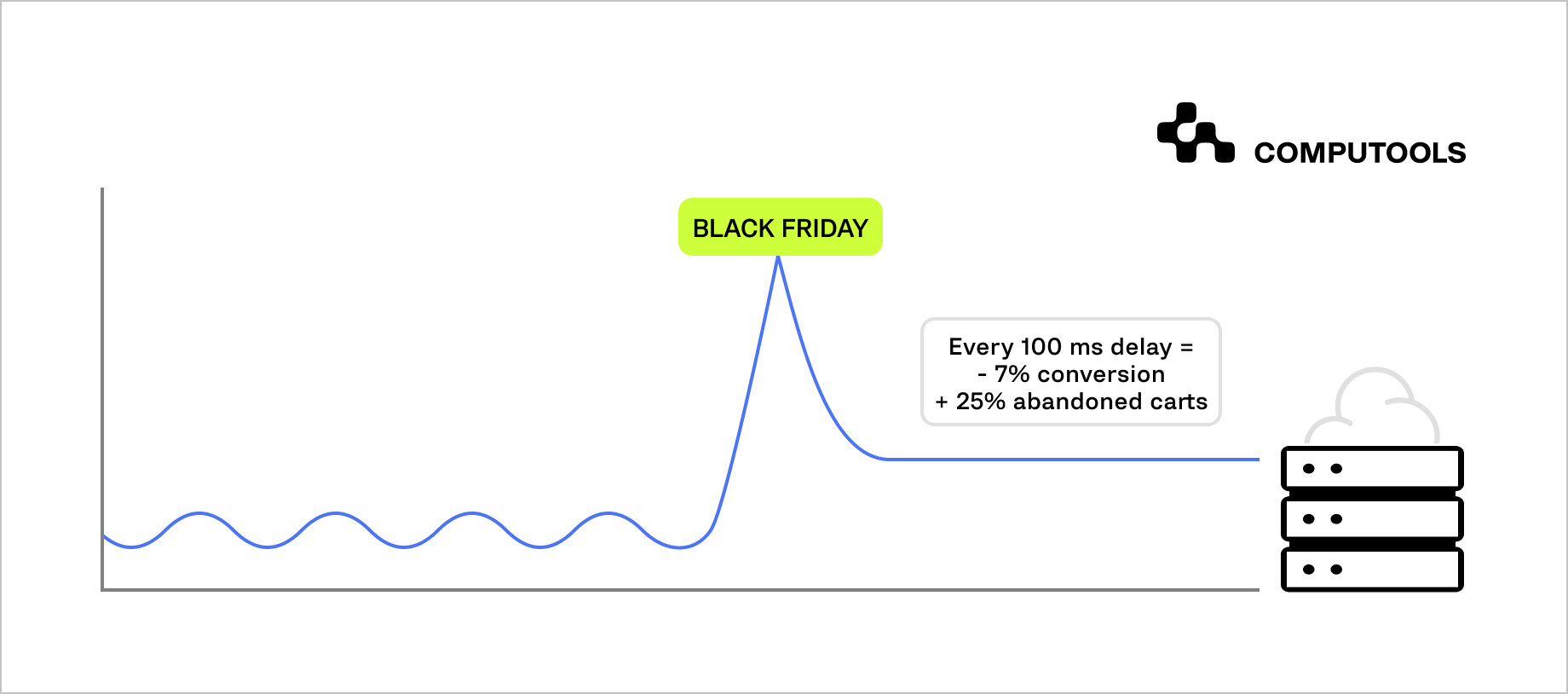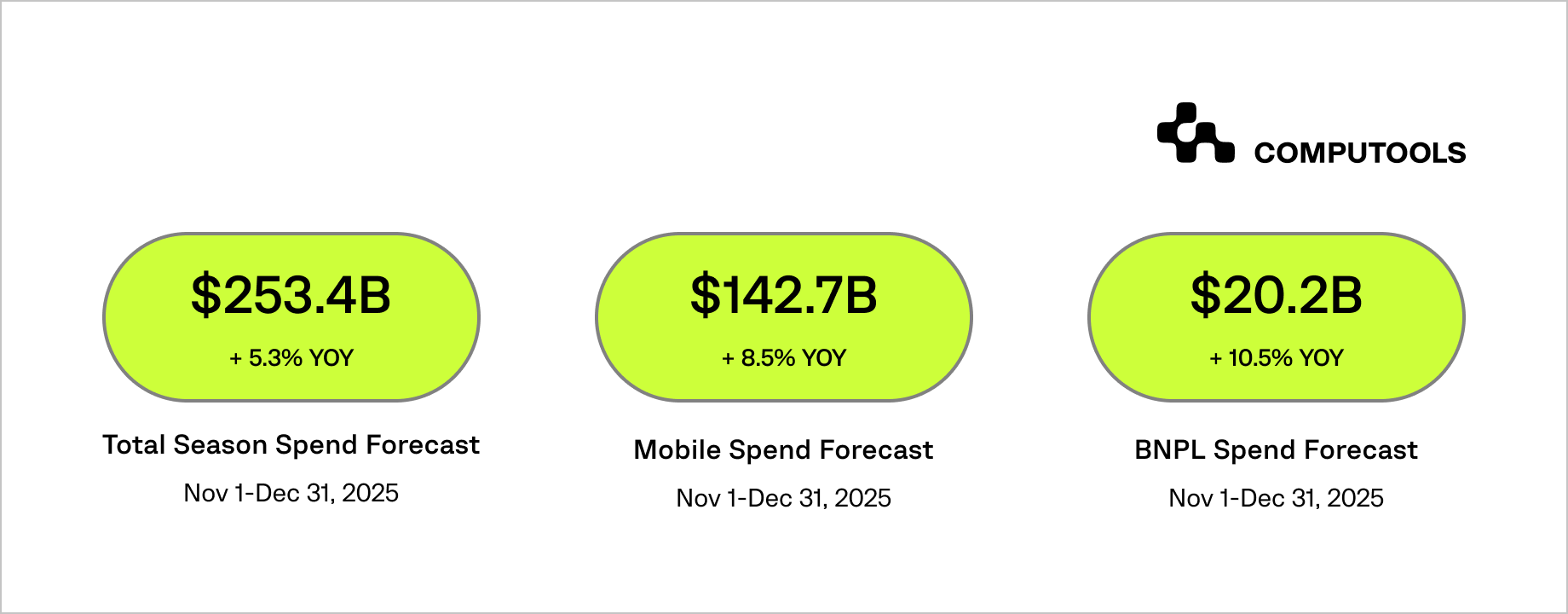Global fashion eCommerce is projected to reach $1.2 trillion by 2027, fueled by flash sales, influencer drops, and holiday peaks. Yet 65% of fashion retailers still experience site crashes or slowdowns during major campaigns.
On Black Friday, traffic can jump 10–12x, and every 100 ms delay cuts conversions by 7%, while sluggish performance drives 25% more cart abandonments. Every second lost costs revenue.
To stay competitive, fashion brands must scale retail eCommerce platforms that handle surges, process transactions instantly, and remain stable under pressure. Slow sites frustrate customers, leaving retailers with lost sales and lasting reputational damage.
Computools helps retailers prevent these losses through smart, scalable engineering. As a trusted technology partner for global brands, we accelerate digital transformation and strengthen resilience under growing market pressure. Our retail software development services span from concept and UX to scalable cloud infrastructure and ongoing optimization. We apply the best practices in scaling retail eCommerce, delivering secure, flexible, high-performing solutions that adapt to shifting consumer demand.

How we built a scalable fashion retail platform for a global leader in apparel
Our client, a global retail company, needed a unified digital platform to oversee product data, design assets, and assortment planning across teams and regions. Existing tools and disconnected systems slowed workflows and impeded rapid responses during high-traffic campaigns.
Computools partnered with the client to create the Apparel Platform, a collaborative system that connects merchandisers, designers, suppliers, and factories in real time. The platform introduced digital workspaces for line planning, product presentations, and virtual assortment testing, enabling teams to make faster, data-driven decisions and maintain smooth performance during seasonal surges.
Built on a modern, scalable architecture, the solution supports continuous synchronization and efficient data flow across departments. This approach became a foundation for scaling online retail operations, helping clients shorten production cycles, improve coordination, and minimize downtime during demand peaks.
As part of our broader expertise in fashion and apparel software development, Computools delivered a flexible and reliable ecosystem that now accelerates collaboration, boosts profitability, and keeps the retailer’s digital infrastructure ready for growth.

How to scale a fashion retail platform for high traffic and seasonal peaks
Handling seasonal traffic spikes in fashion eCommerce takes more than server space; it needs scalable architecture and real-time analytics. Computools helps brands scale fashion eCommerce websites and operations through data-driven engineering that keeps performance steady under peak demand. Here is a 10-step guide on how to scale retail ecommerce platform for high traffic and seasonal peaks.
1. Plan and Forecast Demand Early
Scalability starts with foresight. For fashion retailers, the ability to predict demand is the backbone of fashion retail platform scalability. Traffic surges during campaigns, influencer drops, or holiday sales can’t be managed reactively; they must be anticipated and engineered.
Adobe’s 2025 Holiday Shopping Trends Report forecasts online retail reaching $253.4 billion (+5.3% YoY) from November to December, marking the first quarter-trillion-dollar holiday. Mobile will dominate at 56.1%, with AI-driven traffic up over 515% YoY. These figures show how volatile and data-driven retail peaks are, highlighting the need to start forecasting 3–6 months before key sales periods.
To identify emerging trends, successful retailers analyze historical traffic, campaign performance, and SKU-level sales velocity. Those who combine early forecasting with predictive analytics experience 20–30% fewer performance issues during high-demand periods.

In the Apparel Platform project, Computools embedded predictive dashboards that visualized sales velocity across categories, channels, and geographies. The system enabled merchandisers to run “what-if” simulations, testing how a regional campaign or limited-edition drop might impact operations and fulfillment.
All departments — from design to logistics — worked within a shared data environment by connecting the platform with PLM and ERP systems. This eliminated guesswork, enhanced coordination, and minimized last-minute bottlenecks. The client achieved greater forecast accuracy and established a scalable foundation to manage unpredictable demand spikes across global markets.
2. Build Scalable Infrastructure
The foundation of performance lies in infrastructure. Scaling online fashion stores requires more than adding servers; it demands a flexible architecture capable of adapting to fluctuating demand in real time. Many retailers still rely on rigid, monolithic systems that perform well in steady traffic, but collapse when user activity multiplies during seasonal campaigns.
In the Apparel Platform project, we designed a modular cloud-based infrastructure that dynamically adjusted to traffic surges across regions. The system automatically scaled resources during heavy loads, such as global collection launches or flash sales, and optimized costs by scaling down during low-traffic periods. This ensured consistent performance and uninterrupted access for thousands of concurrent users.
Our engineers implemented distributed computing, load balancing, and real-time monitoring across multiple cloud environments to achieve this. The development process followed an agile Scrum framework with short sprints, continuous feedback, and incremental feature delivery, ensuring the platform evolved smoothly without downtime.

This approach gave the client full elasticity and stability. As the retailer’s online presence expanded to new markets, the infrastructure effortlessly supported additional integrations, localized storefronts, and increased user traffic without compromising performance. This adaptive foundation transforms infrastructure from a cost center into a strategic growth asset for fashion enterprises operating at scale.
3. Strengthen Your Tech Ecosystem
Modern fashion retail thrives on interconnected systems. Fragmented software stacks where merchandising, design, and logistics operate in silos slow down communication and increase the risk of data errors during high-traffic periods. True scalability requires a unified digital backbone that syncs every workflow through integrated fashion retail technology solutions.
Computools helped the client replace disjointed tools with a cohesive ecosystem that linked PLM and analytics modules into one continuous data flow in the Apparel Platform project. This eCommerce integration enabled real-time visibility across departments, allowing merchandisers, designers, and production managers to access identical information simultaneously.
For example, when design teams updated product specifications or marketing adjusted pricing, those changes instantly reflected across all connected systems, from planning dashboards to supplier interfaces. This eliminated duplicate work, reduced manual input errors, and ensured everyone worked from the same version of the truth.
The result was a 360° operational view that empowered faster decision-making and improved cross-department collaboration. With a centralized ecosystem, the retailer could adapt instantly to shifting market conditions and rapidly manage peak-season operations.
4. Optimize for Performance and Speed
During peak campaigns, milliseconds define success. Fashion brands that fail to deliver a seamless digital experience lose potential buyers before checkout. To stay competitive, it’s crucial to optimize eCommerce for seasonal traffic, ensuring that your platform remains fast, stable, and responsive when user volume multiplies.
Improving page load time by just one second can boost conversion rates by up to 27% in fashion eCommerce. This correlation between speed and sales highlights why performance optimization isn’t a one-off fix, but an ongoing strategy that protects revenue during high-demand events.
Working with the Apparel project, we simulated heavy-load conditions and optimized front- and backend workflows to reduce latency across global regions. CDN deployment distributed content closer to customers, while caching and asynchronous rendering kept image-rich pages lightweight.
The result was consistently fast response times across mobile and desktop, even when traffic increased tenfold during collection launches. Through high traffic eCommerce solutions, Computools helped the client transform seasonal spikes into peak-profit moments instead of system stress tests, turning speed into a measurable business driver.
5. Design a Digital Backbone for Growth
Long-term scalability involves managing current traffic and preparing for future growth. Building a flexible retail digital infrastructure for growth allows fashion brands to evolve without system overhauls every season. Scalability becomes part of the business DNA rather than an emergency response.
Computools created a modular architecture for the Apparel project that supported new integrations, user roles, and regional expansions without disrupting existing workflows. The system was designed to scale horizontally, meaning additional services from analytics to supplier management could be added on demand.
This approach gave the retailer full control over its evolution. Real-time synchronization ensured that every department, from production to marketing, operated on unified data regardless of region.
The result was a resilient ecosystem, one that not only handled traffic surges but also supported continuous innovation. For modern retailers, this kind of infrastructure turns digital transformation into a competitive advantage, enabling growth without sacrificing stability.
6. Develop Clear Scalability Strategies
Even the most advanced technology fails without a clear roadmap for growth. Sustainable performance requires structured planning, which Computools defines as fashion retail platform scalability strategies. These strategies align technical capabilities with business priorities, ensuring every system component scales efficiently under pressure.
In the Apparel case, our engineers developed a proactive scalability roadmap and load management system framework built around predictive monitoring, automated load distribution, and predefined performance thresholds. The platform used traffic modeling to forecast surges and dynamically allocate cloud resources before bottlenecks occurred.
This predictive approach turned scaling into a seamless, invisible process. When campaign activity spiked across regions, the system automatically balanced requests, synchronized databases, and prevented downtime. As a result, the retailer maintained uninterrupted service while supporting thousands of concurrent users and new digital channels.
By treating scalability as an ongoing strategy rather than a one-time fix, the client gained long-term resilience and a platform capable of evolving alongside consumer trends and global expansion.
7. Focus on Continuous Performance Optimization
Fashion retailers that thrive during rapid market shifts treat optimization as a continuous cycle rather than a post-launch activity. Computools applies this principle through systematic performance optimization for fashion retail platforms, ensuring each release improves efficiency, speed, and user experience.
In the Apparel Platform project, ongoing performance reviews were integrated into the development pipeline. After every major campaign, the team analyzed key metrics, traffic behavior, latency, database load, and conversion patterns to identify areas for improvement. This allowed engineers to fine-tune both infrastructure and user interface without interrupting operations.
We implemented real-time monitoring and alert systems that tracked system health and user interactions. This constant feedback loop enabled proactive action before minor issues could escalate into performance drops.
As a result, the platform’s response times, transaction speed, and operational stability improved even after deployment. This iterative approach ensured the retailer’s technology stayed ahead of market demands, keeping every collection launch as smooth and fast as the previous one, no matter how high the traffic climbed.
8. Build Systems to Handle Seasonal Surges
The real test of scalability comes when traffic hits its highest point. During seasonal sales or limited-edition drops, systems must stay online and perform flawlessly under pressure. Computools develops software solutions to handle seasonal traffic in retail platforms, ensuring stable performance and a frictionless shopping experience, no matter how intense the demand.
The Apparel Platform project achieved this resilience through distributed cloud infrastructure, advanced caching, and load-balancing mechanisms that automatically reallocated resources during spikes. These systems kept the platform responsive and prevented performance degradation when campaign traffic surged more than ten times.
We also implemented asynchronous order processing and adaptive queue management for critical checkout and payment verification operations. This allowed thousands of simultaneous transactions to proceed without bottlenecks or errors, even when demand peaked across multiple regions.
The result: zero downtime during major events, consistent response times, and uninterrupted customer journeys.
9. Implement Proactive Performance Strategies
Scalability is about reacting quickly but also preventing issues before they appear. Computools applies strategies to optimize performance of fashion retail websites for high demand that combine predictive analytics, automation, and continuous monitoring to anticipate and neutralize performance risks.
In the Apparel Platform project, our engineers introduced monitoring tools and real-time analytics dashboards that tracked system performance, user activity, and data synchronization speed across all modules. This made it possible to detect and resolve bottlenecks before they affected operations.
The development process included regular performance reviews after each iteration, ensuring the platform stayed reliable, fast, and responsive as new features were added. This iterative, proactive approach allowed the client’s team to focus on product launches and creative work, confident that the system was prepared to handle any surge in traffic or data volume.
10. Prepare for Market Expansion
Once stability and scalability are achieved, the next step is global readiness. For modern retailers, growth means entering new regions, supporting diverse customer bases, and maintaining the same high performance everywhere. Computools provides practical infrastructure scaling tips for fashion marketplaces during peak seasons to help brands expand without losing speed, quality, or reliability.
The client’s growth strategy in the Apparel Platform project required simultaneous launches in several international markets. Computools implemented multi-region cloud deployment and localized data management to support this. Each regional instance could handle its traffic and compliance requirements while staying connected to a unified global infrastructure.
The system’s modular design allowed easy integration of new languages, currencies, and fulfillment partners. As a result, the retailer could adapt to local market conditions while maintaining consistent performance and UX across all digital touchpoints.
By treating expansion as a continuation of scalability, not a separate initiative, the company created a foundation for sustainable global growth. Regardless of scale or geography, every campaign runs on an architecture designed to perform at its best during steady traffic and seasonal peaks.
Mastering seasonal peaks in retail platform management means transforming unpredictability into opportunity. With the right technology, strategy, and scalability mindset, fashion brands can turn every campaign spike into lasting growth and stronger customer loyalty.
In a world where mobile commerce continues to grow in importance, this overview highlights the top companies assisting retailers in bringing their solutions to mobile platforms. 20 Best Mobile App Development Companies for Retailers in 2025.

Traffic surging? Revenue shouldn’t drop. Scale your retail platform for any peak.
Why reliability matters when you scale retail eCommerce
Peak traffic events reveal how well a business is built to perform. They separate stable, scalable platforms from those that crumble under pressure. To succeed, retailers must design systems that can scale retail eCommerce smoothly, supporting high transaction volumes and flawless user experiences when demand surges most.
Reliability is the objective measure of readiness. Downtime during high-demand periods not only causes short-term sales loss, but it also damages credibility and loyalty, sometimes irreversibly. In fashion retail, competition and customer expectations are relentless; even seconds of inaccessibility can mean thousands of lost orders.
• Revenue Impact. Every minute offline equals lost sales. During major campaigns, downtime can wipe out millions in potential revenue and push customers toward competitors who remain accessible.
• Brand Reputation. Trust is earned through consistency. A single failure amplified by social media can undo years of brand building, while reliable systems quietly reinforce authority and consumer confidence.
• Customer Trust. Shoppers expect seamless transactions and secure data handling. Any disruption triggers doubt about a brand’s reliability, and doubts rarely convert into sales.
In the digital economy, reliability is strategic. Businesses that treat uptime as a core value turn seasonal demand surges into long-term growth and stronger customer loyalty.
What causes downtime in retail platforms
Even the most advanced fashion platforms can fail under pressure if their architecture isn’t built for resilience. Understanding the root causes of downtime helps retailers prepare, prevent, and respond quickly, the essence of effective Fashion eCommerce infrastructure scaling.
1. Software and Hardware Issues
Outdated servers, power outages, or unoptimized code often trigger unexpected slowdowns or full system crashes. During major sales events, such failures can multiply across regions.
Retailers need proactive maintenance schedules, redundant backups, and 24/7 support coverage to minimize risk—every second counts during an outage. Rapid diagnostics and instant escalation distinguish between a minor delay and a costly blackout.
2. Cyberattacks
Malicious traffic, mainly distributed denial-of-service (DDoS) attacks, can overwhelm servers with fake requests, preventing legitimate shoppers from accessing the store. Strengthening security through two-factor authentication, regular vulnerability testing, and real-time intrusion monitoring helps maintain system integrity.
3. Third-party integrations
Each connected plugin or API adds complexity and risk. If not optimized, payment gateways, analytics scripts, and personalization tools can become hidden bottlenecks. Regular load testing and performance audits ensure these integrations scale alongside the core platform.
Computools emphasizes website load balancing for retail, distributing traffic intelligently across servers to maintain consistent speed and availability even when one component slows down.
By identifying these causes early and designing architecture around prevention, brands build a more stable, self-healing system.
Learn how to reduce losses, optimize logistics, and test your idea efficiently with this step-by-step guide to building an IoT MVP for grocery and retail supply chains. Read our article How to Build an IoT MVP for Grocery and Retail Supply Chains.
Why choose Computools
Computools helps retailers stay stable when demand surges and technology is under pressure. Our team focuses on building systems that scale smoothly, perform consistently, and deliver results you can measure.
Through tailored eCommerce development services, we create fast, secure, and resilient platforms designed for real traffic, not test environments. Every solution is optimized for business continuity and user experience.
By applying advanced technology for scaling retail eCommerce platforms, Computools ensures your infrastructure adapts to traffic peaks automatically, keeping operations efficient and costs predictable.
We also develop digital tools to scale retail brands, connecting analytics, logistics, and marketing into one ecosystem that grows with your business, not against it.
For expert guidance on reducing system load and scaling, write to us at info@computools.com.
To sum up
Seasonal peaks are no longer unpredictable; they’re measurable, manageable, and profitable for brands that build the proper foundation. In fashion and retail, success now depends on having high-traffic eCommerce solutions that combine flexibility, intelligence, and speed. The ability to handle millions of concurrent users and process thousands of transactions per second is a business imperative.
Proper retail platform performance optimization goes beyond fixing speed, designing systems that anticipate demand, scale automatically, and maintain seamless operation under pressure. Each campaign or seasonal surge becomes a chance to improve user experience, strengthen conversion, and boost long-term loyalty.
With retail platform high availability solutions, brands can turn volatility into an advantage. Every click, checkout, and customer interaction remains smooth, consistent, and reliable, no matter how extreme the load. In a market where milliseconds define success, scalable technology determines who leads and who fails.

Computools
Software Solutions
Computools is a digital consulting and software development company that delivers innovative solutions to help businesses unlock tomorrow.









“Computools was selected through an RFP process. They were shortlisted and selected from between 5 other suppliers. Computools has worked thoroughly and timely to solve all security issues and launch as agreed. Their expertise is impressive.”